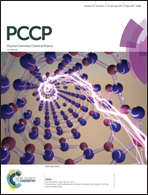“Energy Relay Center” for doped mechanoluminescence materials: a case study on Cu-doped and Mn-doped CaZnOS
Abstract
We unraveled the mechanisms of transition metal-doped mechanoluminescent materials through a case study of CaZnOS. We found that the native point defect levels in Cu or Mn-doped CaZnOS system acted as energy relay centers for luminescence energy transfer. In combination with native point defect levels, discussed in a previous study [Phys. Chem. Chem. Phys., 2016, 18, 25946], we found that phosphor luminescence belongs to two different mechanisms. For Cu-doping, it occurs by the path via the conduction band minimum to the Cu-t2g level of the 3d orbital localized in the band gap. The hole-drifting effect was found to support the reported red-shifting of the emission. Both reversible and irreversible mechanical quenching were attributed to the spatially separated electrons recombining with the hole localized on the Cu-t2g level within the gap at levels below or above respectively. For Mn-doping, this occurs by a collaborative luminescence assisted by native point defects, and the excited states of Mn2+ overlap with the conduction band edge. The coexistence of MnZn and MnCa was confirmed, but was relatively low in MnCa. The concentration quenching effect, as well as the red-shift of absorption, shows a strong correlation with native point defect levels and the relative position of the 4T1(4G) state for both MnZn and MnCa. Further simplified approximations were used for modeling such concentration quenching effects.



 Please wait while we load your content...
Please wait while we load your content...